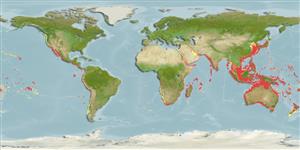Asteroidea |
Paxillosida |
Astropectinidae
Environment: milieu / climate zone / गहराई सीमा / distribution range
पारिस्थितिकी
प्रवाल-भित्ति संयुक्त; गहराई सीमा 0 - 222 m (संदर्भ 106682). Tropical
Southeast Atlantic and entire tropical Indo-Pacific from Red Sea and South Africa to the Hawaiian Islands.
Length at first maturity / आकार / Weight / Age
परिपक्व अवधि: Lm ? range ? - ? cm Max length : 12.0 cm WD पुल्लिंग / अलिंग; (संदर्भ 800)
The five arms have blunt and tapered ends that curve slightly upwards. Both oral and aboral sides are flattened, with the aboral disc being slightly convex. Body color varies from greenish-blue, to brownish-gray and dark reddish-brown. This species is characterized by its distinctive laterally projecting rows of spines on the supero-marginal plate.
Buried in the sand during daytime and crawls on the sand to search for food at night. Feeds primarily on bivalves and gastropods and other small invertebrates buried in the sand (Ref. 800).
Life cycle and mating behavior
परिपक्व अवधि | पुनरुत्पत्ति | मछलीऔ का अंडे देना | Eggs | Fecundity | Larvae
Members of the class Asteroidea exhibit both asexual (regeneration and clonal) and sexual (gonochoric) means of reproduction. Life cycle: Embryos hatch into planktonic larvae and later metamorphose into pentamorous juveniles which develop into young sea stars with stubby arms.
Schoppe, S. 2000 A guide to common shallow water sea stars, brittle stars, sea urchins, sea cucumbers and feather stars (echinoderms) of the Philippines. Times Media Private Limited, Singapore. 144 p. (संदर्भ 800)
IUCN Red List Status
(संदर्भ 130435: Version 2025-1)
CITES status (संदर्भ 108899)
Not Evaluated
CMS (संदर्भ 116361)
Not Evaluated
Threat to humans
Harmless
Human uses
| FishSource |
साधन
अधिक जानकारी
Population dynamicsबाढ़
Max. ages / sizes
Length-weight rel.
Length-length rel.
Length-frequencies
Mass conversion
बहुतायत
Life cycleपुनरुत्पत्तिपरिपक्व अवधिFecundityमछलीऔ का अंडे देनाEggsEgg developmentLarvae PhysiologyOxygen consumption
Human RelatedStamps, coins, misc.
इंटरनेट स्रोत
Estimates based on models
Preferred temperature
(Ref.
115969): 15.3 - 29, mean 27.4 (based on 2738 cells).
Fishing Vulnerability
Low vulnerability (10 of 100).
Price category
Unknown.
